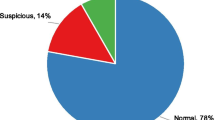Abstract
The topic of neonatal hypoxia is of paramount importance to anyone who cares during pregnancy and childbirth. Modern medicine associates this pathology with severe problems in the prenatal period. Underlying diseases of the mother during pregnancy, her anamnesis of life are the leading causes of complications in the newborn. Nevertheless, patterns of fetal hypoxia and neonatal hypoxia, as well as mechanisms of hypoxic-ischemic encephalopathy in newborns, remains poorly known and require further research. This study is focused on finding risk factors related to the chronic fetal hypoxia and defining a group of signs for diagnosing neonatal hypoxia. The real data of 186 pregnant women at the gestation age from 12 to 38 weeks were analyzed. A methodology for discovering interesting associations in gestation course data is proposed. Technique for association rules mining and rules selection by the neonatal hypoxia under study is discussed. The rules suggest that a strong relationship exists between the specific sets of attributes and the diagnosis. As a result, we set up a profile of the pregnant woman with a high likelihood of hypoxia of the newborn that would be beneficial to medical professionals.



Similar content being viewed by others
References
Kurinczuk, J. J., White-Koning, M., and Badawi, N., Epidemiology of neonatal encephalopathy and hypoxic-ischaemic encephalopathy. Early Hum. Dev. 86:329–338, 2010.
Martinez-Biarge, M., Diez-Sebastian, J., Wusthoff, C. J., Mercuri, E., and Cowan, F. M., Antepartum and intrapartum factors preceding neonatal hypoxic-ischemic encephalopathy. Pediatrics 132(4):e952–e959, 2013.
Allen, K. A., and Brandon, D. H., Hypoxic ischemic encephalopathy: pathophysiology and experimental treatments. Newborn Infant Nurs Rev 11(3):125–133, 2011.
Seikku, L., Rahkonen, L., and Tikkanen, M., Hämäläinen, Е., Rahkonen, P., Andersson, S., Teramo, K., Paavonen, J., Stefanovic, V.: Amniotic fluid erythropoietin and neonatal outcome in pregnancies complicated by intrauterine growth restriction before 34 gestational weeks. Acta Obstet. Gynecol. Scand. 94(3):288–294, 2015.
Milsom, I., Ladfors, L., Thiringer, K., Niklasson, A., Odeback, A., and Thornberg, E., Influence of maternal, obstetric and fetal risk factors on the prevalence of birth asphyxia at term in a Swedish urban population. Acta Obstet. Gynecol. Scand. 81(10):909–917, 2002.
Mertsalova, O.V., Perinatal hypoxic injuries of fetal CNS in high-risk pregnant women (diagnosis, prognosis of outcomes, optimization of pregnancy and delivery management), 2002.
Antonucci, R., Porcella, A., and Pilloni, M. D., Perinatal asphyxia in the term newborn. Journal of Pediatric and Neonatal Individualized Medicine 3(2):e030269, 2014. https://doi.org/10.7363/030269
Hypoxic-Ischaemic Encephalopathy (HIE). Queensland Clinical Guidelines, 2016.
Palsdottir, K., Dagbjartsson, A., Thorkelsson, T., and Hardardottir, H., Birth asphyxia and hypoxic ischemic encephalopathy, incidence and obstetric risk factors. Laeknabladid 93(9):595–601, 2007.
Agrawal, R., Imielinski, T., and Swami, A., Mining association rules between sets of items in large databases. ACM SIGMOD Conference 207-216, 1993.
Kumar, K. P., and Arumugaperumal, S., Association Rule Mining and Medical Application: A Detailed Survey. Int. J. Comput. Appl. 80(17):0975–8887, 2013.
Chaves, R., Gorriz, J. M., Ramirez, J., Illan, I. A., Salas-Gonzalez, D., and Gomez-Rio, M., Efficient mining of association rules for the early diagnosis of Alzheimer’s disease. Phys. Med. Biol. 56:6047–6063, 2011.
Cheng, Chih-Wen, Chanani, N., Enugopalan, J., Maher, K., Wang, M. D., icuARM - An ICU Clinical Decision Support System Using Association Rule Mining. IEEE Journal of Translational Engineering in Health and Medicine, 1, 2013.
Ordonez, C., Santana, C. A., Levien de Braal: Discovering Interesting Association Rules in Medical Data. ACM DMKD workshop, 78–85, 2000.
Kaur, H., Wasan, S. K., Al-Hegami, A. S. and Bhatnagar, V., A Unified Approach for Discovery of Interesting Association Rules in Medical Database. In Advances in Data Mining. Lecture Notes in Artificial Intelligence. - SpringerVerlag, Berlin, Heidelberg, 4065, 2006.
Reps, J. M., Aickelin, U., Ma, J., Zhang, Y. Refining Adverse Drug Reactions using Association Rule Mining for Electronic Healthcare Data. IEEE International Conference on Data Mining Workshop, 763–770, 2014.
Simovici, D.A. Data Mining of Medical Data: Opportunities and Challenges in Mining Association Rules. Retrieved from www.cs.umb.edu/~dsim/papersps/dmmd.pdf, 2012.
Holzinger, A., Interactive Machine Learning for Health Informatics: When do we need the human-in-the-loop? Brain Informatics 3(2):119–131, 2016.
Yildirim, P., Ekmekci, I., and Holzinger, A., On Knowledge Discovery in Open Medical Data on the Example of the FDA Drug Adverse Event Reporting System for Alendronate (Fosamax). In: Holzinger, A., Pasi, G. (Eds), Human-Computer Interaction and Knowledge Discovery in Complex, Unstructured, Big Data, Lecture Notes in Computer Science, LNCS 7947. Berlin: Springer, 2013, 195–206.
Skarga-Bandurova, I., Biloborodova, T., Exploratory Data Analysis to Identifying Meaningful Factors of Hypoxic Fetal Injuries. Herald of the NTU “KhPI”. Series: Informatics and Modelling. – Kharkov: NTU “KhPI”, 44 (1216), 122–135, 2016.
Hahsler, M., Grün, B., Hornik, K., Buchta, C., Introduction to arules - A computational environment for mining association rules and frequent item sets, 2010. http://cran.r-project.org/web/packages/arules/vignettes/arules.pdf. Accessed 23 Nov 2018.
Hegland, M., The Apriori Algorithm – a Tutorial. WSPC/Lecture Notes Series, 9(7), 2005.
Biloborodova, T.O., Models and methods of information technology for automated systems of medical data analysis, PhD diss., V. Dahl EUNU, 2018. https://snu.edu.ua/wp-content/uploads/2018/08/Biloborodova.Dysertatsiya.pdf
Doddi, S., Marathe, A., Ravi, S.S., Torney, D.C.: Discovery of Association Rules in Medical Data http://citeseerx.ist.psu.edu/viewdoc/download?doi=10.1.1.198.4047&rep=rep1&type=pdf
Zhao, Y., Zhang, C., Cao, L., Post-mining of association rules: techniques for effective knowledge extraction. In Information Science Reference, 2009.
Masood, A., Ouaguenouni, S.: Probabilistic Measures for Interestingness of Deviations – A Survey. International Journal of Artificial Intelligence & Applications (IJAIA), 4, 2013.
Billing, V. A., Association rule mining for medical diagnostics. Software Solutions and Systems 2:146–157, 2016.
Author information
Authors and Affiliations
Corresponding author
Ethics declarations
Conflict of interest
None of the authors has any conflict of interest.
Ethical approval
This article does not contain any studies with human participants or animals performed by any of the authors.
Additional information
This article is part of the Topical Collection on Systems-Level Quality Improvement
Rights and permissions
About this article
Cite this article
Skarga-Bandurova, I., Biloborodova, T. & Nesterov, M. Extracting Interesting Rules from Gestation Course Data for Early Diagnosis of Neonatal Hypoxia. J Med Syst 43, 8 (2019). https://doi.org/10.1007/s10916-018-1125-0
Received:
Accepted:
Published:
DOI: https://doi.org/10.1007/s10916-018-1125-0




